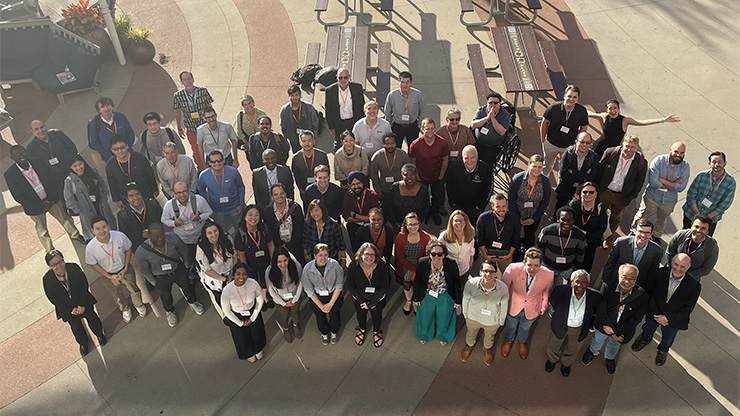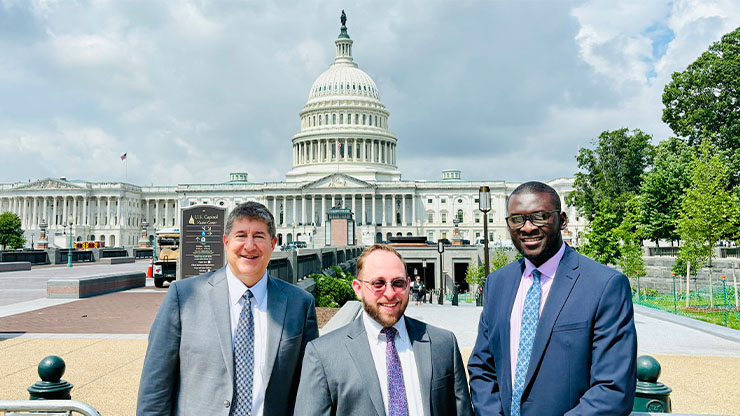SIAM Webinar Examines Recent U.S. Federal Actions and Outlook for the Applied Mathematics Community
The U.S. research community is currently facing a great deal of uncertainty regarding the future of federal scientific funding, reductions in the federal workforce, and changes to research priorities under the Trump administration. Throughout these challenges, SIAM remains committed to its mission of supporting the entire applied mathematics and computational science research community. The Society is dedicated to continued advocacy for sound science policy and federal funding to support critical research and workforce programs, and aims to ensure that its members’ goals and priorities are reflected in this space.

On March 10, SIAM hosted an hourlong webinar that featured its government relations partners, Lewis-Burke Associates LLC, to provide an update on ongoing federal actions, activities, and priorities that impact the scientific community. Alejandro Aceves of Southern Methodist University—SIAM’s Vice President for Science Policy and chair of the SIAM Committee on Science Policy (CSP)—welcomed the virtual audience and introduced Miriam Quintal, a Managing Principal at Lewis-Burke, who presented a comprehensive overview of recent shifts in the federal government.
Lewis-Burke Associates has represented SIAM in Washington, D.C., since 2001 and promotes the Society’s interests across various U.S. federal departments and institutes. Quintal began by acknowledging the destabilizing impacts of the mercurial federal landscape. “I’m going to talk about what you can be doing and what we are doing to advance the priorities of the community,” she said. “We try to be nonpartisan and highly adaptable as government and client interests evolve.” During the second half of the session, Quintal joined Aceves and SIAM Chief Executive Officer Suzanne Weekes to respond to audience questions.
The Federal Landscape for Science Policy
In the November 2024 U.S. election, Republicans gained control of the White House, Senate, and House of Representatives; however, the narrow Republican majority in the House makes it relatively difficult for the party to pass broad legislation without Democratic support. While the new administration has been attempting to quickly implement a number of partisan initiatives, some factors may slow its efforts. Quintal pointed out several noteworthy action areas that contribute to the current political landscape: executive orders, agency personnel and policy, reconciliation, budget processes and appropriations, and opportunity spaces for growing areas of research (see Figure 1).
Over the past few months, U.S. President Donald Trump has used executive orders to fulfill his campaign priorities—spanning issues such as immigration; energy; and equity, diversity, and inclusion—and deeply affect the federal workforce [2]. Particularly alarming for the research community has been an effort to dramatically reduce the workforce at government agencies and cancel existing grants and contracts [1]. The scrutiny on facilities and administrative costs within research grants is also causing financial concerns at scientific institutions. However, many executive orders are being disputed in court by state attorney generals and outside groups, and some have been placed on hold — leading to even more uncertainty.
In the coming months, the Trump administration is expected to emphasize certain research and development priorities and devalue others. Officials have claimed a sustained focus on global competitiveness and national security, particularly in critical and emerging technologies — including some that are important to the SIAM community, such as artificial intelligence (AI) and quantum science. An increased emphasis on energy dominance is directing attention towards fossil fuels and mining, and away from clean energy and climate science. In health science, priorities appear to be shifting towards chronic diseases, preventative health, alternative therapies, and AI in healthcare, with a reduced interest in infectious diseases and health disparities. This give-and-take between disciplines that are coming in and out of favor is playing out among various federal agencies. “All of these priorities are in the broader context of reducing federal funding overall,” Quintal said.

Numerous cabinet and advisory nominations will influence the science policy sphere, and Lewis-Burke and the SIAM CSP have already engaged with several incoming agency leaders in their past or present roles. Some appointees may potentially share interests with the SIAM community; for instance, Michael Kratsios—the nominee for director of the Office of Science and Technology Policy (OSTP)—has a background in AI, as does much of the OSTP staff. Quintal identified relevant major legislation to watch in the ongoing congressional term, including the reauthorization of the National Institutes of Health (NIH) and the National Defense Authorization Act (see Figure 2).
Another way in which federal policy impacts the scientific landscape is through budget and appropriations. The fiscal year (FY) 2025 appropriations process has been in flux, causing a threat of a possible government shutdown that loomed over the March 10 webinar. Nevertheless, preparations for FY 2026 are also underway. “As a community, we are thinking about our messages and priorities for that 2026 budget and appropriations process,” Quintal said. The FY 2026 appropriations proceedings—which will determine spending levels for federal agencies, including those of interest to the SIAM community—are just beginning and will continue through October. Republicans will also attempt to use a budget reconciliation procedure to pass a tax bill without any Democratic votes in favor [3]. That process will thus be a major focal point for Republicans as they seek to enable tax changes—including a potential tax on graduate student fellowships—and further the administration’s priorities on energy, immigration, defense, and other areas.
Concerns From the SIAM Community
The webinar provided an opportunity for members of the SIAM community to ask questions about their specific concerns, including the potential reversion of established initiatives from previous administrations. While the future of the Creating Helpful Incentives to Produce Semiconductors (CHIPS) and Science Act is somewhat uncertain, Quintal affirmed that the act does have fairly broad bipartisan support in Congress [4]. Attendees also inquired about the Nelson Memo, which encourages equitable public access to the outputs of federally funded research. The memo currently still stands, but its future is unclear.

One major point of discussion was the potential deletion of federal data that is necessary for scientific research. Participants shared that the Massachusetts Institute of Technology Libraries provide instructions for retaining access to government data for research purposes, and several organizations and archives—including the Data Rescue Project, Harvard Law School’s Library Innovation Lab, and DataLumos—are working to preserve at-risk federal data.
Finally, an attendee asked whether it is still worthwhile for junior faculty to apply for federal grants. Aceves noted that writing these proposals can be a valuable scientific exercise, and opportunities are always worth pursuing. “One of the benefits of writing proposals is to broaden your ideas,” he said. “My overall recommendation is to keep putting your ideas forward and be collaborative.”
SIAM’s Advocacy Efforts
At the upcoming SIAM CSP meeting in early April, committee members will meet with federal agency representatives and congressional offices on Capitol Hill to discuss the SIAM community’s priorities for the upcoming FY and advocate for the importance of specific federal initiatives and departments, such as the U.S. National Science Foundation, NIH, Department of Energy’s Office of Science, and basic research at the Department of Defense. Furthermore, the CSP plans to respond to the OSTP’s Request for Information on the Development of an AI Action Plan and detail requirements in terms of research, infrastructure, workforce, and education.
As needed, SIAM and Lewis-Burke will engage with relevant legislation on topics like quantum science, AI, tax impacts on graduate education, and high-skilled immigration. SIAM also works closely with other advocacy groups and mathematics societies that share an interest in these issues. “We are trying to be part of coalitions where we can,” Quintal said. “How can we ensure that SIAM is at the table for these discussions?”
Opportunities for Involvement
Quintal, Aceves, and Weekes all encouraged attendees to engage with their congressional representatives about issues of concern or opportunities of interest. “Share the things that you’re concerned about, but keep it personal to what you’re an expert in and what you’re impacted by,” Quintal said. “Whenever you can talk about your own story and stories that are really local, that makes the most impact.” The SIAM Science Policy webpage provides instructions on how to contact one’s senator and House of Representatives member, as well as additional resources such as prior SIAM testimonies and position statements. Interested individuals can also get involved with the SIAM CSP or apply for the SIAM Science Policy Fellowship Program.
Various platforms offer comprehensive sources of information about ongoing developments in science policy. For instance, Science maintains a Trump Tracker with frequent news roundups, and the University of California San Diego hosts a list of tracking tools related to the U.S. government. Given the rapid changes in policies and procedures, Quintal asked attendees to be gracious as they interact with scientific offices at the federal level. “Please be patient with your federal partners and program officers,” she said. “They are facing a lot of impacts and dealing with a really uncertain time.”
SIAM would like to hear from community members who have been affected by federal funding changes and other administrative actions; as such, the Society has created an online form through which individuals can share this information (either with or without personally identifying details). These stories will help inform SIAM’s future initiatives, activities, and advocacy. “We have to be proactive to shape the outcomes, advocate for the community, and affect the things that are important for us,” Quintal said.
References
[1] Hernandez, J. (2025, February 4). DOGE is making major changes to the federal government. Is it legal? NPR. Retrieved from https://www.npr.org/2025/02/04/nx-s1-5286314/department-of-government-efficiency-doge-explainer-elon-musk.
[2] Merrill, C., & O’Kruk, A. (2025, March 19). Tracking Trump’s executive actions. CNN. Retrieved from https://www.cnn.com/politics/tracking-trump-executive-orders-actions-dg/index.html.
[3] Raju, M. (2025, February 13). In Congress, what’s the difference between a budget resolution, reconciliation and spending bills? CNN. Retrieved from https://www.cnn.com/2025/02/13/politics/budget-resolution-reconciliation-spending-bills-explainer/index.html.
[4] Sorg, L. (2025, March 3). MDS24 fireside chat explores the U.S. CHIPS and Science Act and its influence on data science research. SIAM News Blog. Retrieved from https://www.siam.org/publications/siam-news/articles/mds24-fireside-chat-explores-the-us-chips-and-science-act-and-its-influence-on-data-science-research.
About the Author
Jillian Kunze
Master's student, Drexel University
Jillian Kunze is the former associate editor of SIAM News. She is currently a master’s student in data science at Drexel University.

Related Reading



Stay Up-to-Date with Email Alerts
Sign up for our monthly newsletter and emails about other topics of your choosing.



